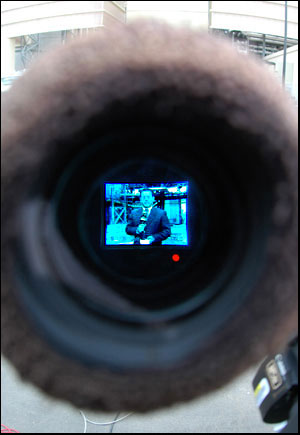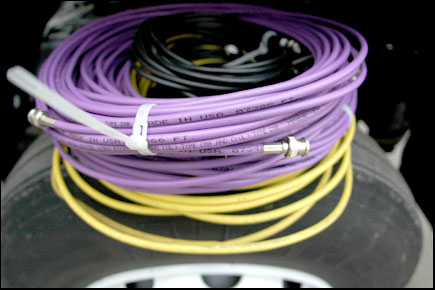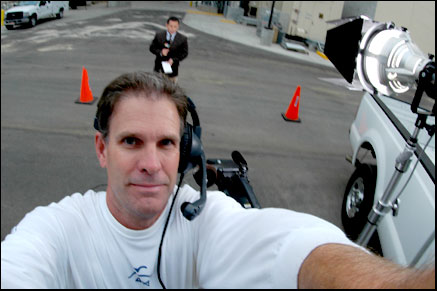RIPPLES
THROUGH THE WEEK
By Mark Neuling
Freelance
As it is with any story of national importance, broadcasters in
the television news business attempt to find local stories relevant
to events happening thousands of miles away. Hurricane Katrina
affected even the business news I shoot for CNBC in Palo Alto,
California. By Friday, four days after the storm, we had done Katrina
related stories for three days including two remote live shots.
Monday didn’t start out to be that unusual a day. Of
course the big story was going to be Hurricane Katrina and the
impact that it was going to have on Louisiana. We had been
watching the news stories coming out of the region. Very
typical television news stories with correspondents out in the
rain and wind doing their stand ups looking like the proverbial
drowned rat. In hindsight some of these stories now appear silly
and almost childish when contrasted to the seriousness of the disaster. It
really seemed like this was gong to be just a lot of wind and rain
and that by chance the brunt of the storm would bypass New Orleans.
We got a last minute assignment to do a weather related story and
a live shot from Silicon Graphics in Mountain View, California. They
have a super computer that can create models of when and where
a storm might hit. Companies like Sears and Wal-Mart use these
models, with the aid of staff meteorologists, so that they can
better plan routes for truck and rail traffic around inclement
weather.
As the week progressed it became clear that Hurricane Katrina was
going to have an effect on the entire nation, and that this would
be a story that we would be covering for weeks to come.
I walked in to work on Wednesday morning and almost immediately
headed back out to shoot footage of service stations as the price
of gasoline soared in the wake of the hurricane. Again we
went live, as did everyone else it seemed, from in front of a gas
station while the price of gas climbed towards a seemingly impossible
$4.00 a gallon for Supreme.
Friday started out with a click of the front door as my wife took
the dog out for his early morning walk. It’s their time together,
their ritual. I poured some cereal and put an English muffin
in the toaster and pressed the lever. Downstairs where we
charge the cell phones, I heard mine begin to ring. It was
barely 6 a.m. and since I routinely wasn’t due in to work
for another 90 minutes this couldn’t be good.
Jim Goldman our bureau chief was on the other end, sounding awfully
darn cheerful for so early in the morning. We were going
to do our third remote live shot of the week from the Altamont
Pass region outside of Livermore California. Our story was
to be on alternative energy sources and the Altamont Pass is sprinkled
with windmill farms. Each windmill generates about enough
energy for three suburban homes.
We were scheduled to do our first hit in the seven o’clock
hour; Jim was trying to push it as late as possible in the block. Russ,
the truck operator, was already on his way and would give me directions. Jim
would meet us there; we could pull this off but it was gong to
be close, and I had a dilemma at home.
I needed to leave almost immediately and my wife had just left,
there was no one around to watch our daughter. It’s funny
how the mind almost immediately forms a checklist of options to
weigh. My first thought was to see if my wife had taken her
cell phone. I found her fanny pack on the kitchen counter,
cell phone safely zipped up inside. I could hope she’d
cut her walk a little short and I’d just wait. I’d
have absolutely no room for error, and I was faced with a good
45 minute drive in commute traffic to a still to be determined
location. What to do? What every kid does, I called
mom.
My 79-year-old mother groggily answered the phone. I explained
the situation to her. She said she’d put on a housecoat
and be right over, but just before she hung up she asked for directions
to our new house. Even though it’s been more than eight
months since we moved, and mom’s been here many times, she’ never
quite learned the route to our place. I hung up and kept
my fingers crossed that she wouldn’t get lost. I skipped
shaving and jumped into the shower. The English muffin lay cold
in the toaster, the cereal still in its bowl.
My mom made it, five minutes later than I would have liked but
there she was at my front door, dressed with perfect makeup. I
grabbed a banana and some water and took off, I had already loaded
the van with my camera, and the little sustenance I’d brought
would be the only thing I would have to eat or drink for the next
seven or eight hours
Despite less than stellar cell phone connections in the
hilly regions of the east bay, Russ managed to give
me dead on directions to his location. I
surprised him when I pulled up. There had only been three or four cars
pass by on this God-forsaken road in the middle of practically nowhere
but there were plenty of windmills dotting the hills of this pastoral setting.
I set up my camera and a simple reflector far enough from the truck so
that it’s generator wouldn’t interfere with our audio. I
could hear the turbines of the windmills hum in the distance. Jim arrived
at the remote truck a short time later; he was not in the best of moods.
Our shot in the
seven o’clock hour had been moved, and on his drive
out to Livermore a rock had fallen off a truck and cracked
his windshield. So in addition to having to write
his story, he also had to deal with getting someone to
come out and change his windshield. Yes, it was going
to be a long day and we had nearly three hours to kill
before our first hit. I shot some b-roll of the churning
windmills for our package.
|

© Mark Neuling
A satellite truck parked beside an electrical plant during
a typical remote shoot. Trucks like this can cost a million
dollars. We were doing a follow-up story on the effect
that Hurricane Katrina will have on energy prices.
|
|
© Mark Neuling
Jim Goldman, bureau chief and reporter for CNBC in their
Silicon Valley Bureau, and one of the best correspondents
in the business. Sometimes there can be a lot of waiting
around to file a report. |
|
Television
is all about illusion; it’s only what you see on the
screen that matters. I had set up along the side
of the road, far enough off the road for safety. There
was a small drainage ditch that ran down the middle of the
shoulder. I was on one side, and Jim would be on the
other side, next to a fence, standing on a light case to
elevate him high enough so that windmills could be seen over
his shoulder. Since we’d chosen a cow pasture
to set up next to we joked about methane gas as an alternative
energy source. Back up the road apiece, the ditch would
serve as a latrine for our all male crew. |
| Just before eleven,
five hours after Jim had called, we set up for our first
hit. Jim was atop the light box, microphone clipped
to his lapel and I was behind the viewfinder. We were
about ten minutes out when I noticed a shadow across his
face. The sun was straight overhead and the power lines
above us were casting a shadow directly across his countenance. No
matter where I tried to move him, the shadow seemed to follow.
We scrambled for a new position. Fortunately there
were only cows and crows to watch and wonder, as to why these
two crazy men appeared to stamp out some imaginary wildfire. |

© Mark Neuling
From behind the viewfinder, this is what the cameraman
sees. |
|

© Mark Neuling
There are lots of cables to set up during a remote shoot. |
|
At Jim’s suggestion, he moved across the trench and
I backed up nearly into the road. Our cables were tangled
in the dry grass and brush, and twisted around the legs of
the reflector. In the scramble, the tiny windscreen
had come off the lavaliere microphone, lost in the long, yellow weeds. We
were at a windmill farm for goodness sake, there was going to be wind! Through
either luck or preparedness I had a spare windscreen there in my bag. At
last we were repositioned and ready for our shot; and then they killed it. |
The President had been
on the ground in the Gulf Coast and all the networks had carried
his press conference. When the
President speaks we listen, but it throws the well-oiled schedule
of live
network news into a spiral and some things just have to go. We
were one of the elements to go. It would be another three-hour
wait. During the downtime Jim got his windshield replaced,
and still managed to work on his story.
We normally use a satellite-truck out of San Francisco. For
something like 50 years, KRON had been the NBC affiliate in the
Bay Area. About
four years ago they lost their affiliation and have been trying
to make a go of it as an independent. They’ve beefed up their
news coverage, but gone are the days of Friends and Frasier, only
to be replaced by Fear Factor and Dr. Phil. After losing
money on news for years, management has made the decision that
reporters are to shoot and shooters are to report. I spend
time joking with Russ on his future as a reporter. Needless
to say he finds my humor less than amusing. But this is a
trend in the television news business. If a major station
in the number five market can go to one-man-bands what hope is
there for the rest of us?
| Technically
the hit before two p.m. went off without any problems. But
there we were, in place for some six hours, middle of nowhere,
and wouldn’t you know it but as we went live, a car
full of teenagers drives by honking their horn and screaming
at the top of their lungs at us. Jim never flinched, but
I could hear the director back in New Jersey chuckle as the
car sped away. One more hit to go, but it was time
for lunch, we drove in to town for burgers and root beer
floats courtesy of the NBC peacock. Russ and Jim had
onion rings while I had fries. |

© Mark Neuling
"A remote shot can be simple, or involve lights, reflectors,
scrims, flags or a combination of lighting control
tools. Some of which I actually know how to use."
The author sets up
his equipment as Reporter/Bureau Chief Jim Goldman stands
ready in the background. |
|

© Mark Neuling
It takes a competent and dedicated operator to run a vehicle like this. This
truck came down from Sacramento for our shoot. |
|
The KRON satellite truck is a roomy one, there was ample space for us to eat
our lunch and watch the coverage of Hurricane Katrina. CNN and Wolf
Blitzer seemed to have one technical problem after another. When you
work on the high wire of live network news there is a certain perverse pleasure
in watching the competition crash and burn because on any day it could be
our turn to go up in flames. |
With
the door to the truck shut and the air conditioner on to
cool us from the late summer heat, I couldn’t help
but feel as if we were in some spacecraft on the surface
of some far away planet; our mission nearly complete, just
one more task to accomplish before we could blast off and
head for home. Lunch had made us drowsy. Scripts were
done and footage had been fed long ago, we could only wait
for our turn. The network extended its news coverage
that day and our last hit finally came about ten hours after
we’d started.
|

©
Mark Neuling
Scripts can be written and filed with the aid of
a wireless device such as a BlackBerry.
|
|
Funny how these shoots use to make me so nervous.
© 2005 Mark Neuling
The opinions expressed are solely those of the author.
Email address is now – theneulings@Juno.com
|








